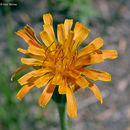en
names in breadcrumbs


Agoseris aurantiaca is a species of plant in the family Asteraceae, commonly called orange agoseris or mountain dandelion. It is widespread in western North America.
Agoseris aurantiaca is a perennial herb or subshrub[2] growing to 60 centimeters (24 inches) in height.[3] It produces a basal rosette of leaves, which are 5–35 cm (2–14 in) long.[3] There is no stem, but it does produce several stem-like peduncles. Between June and August, each peduncle bears a single flower head 2.5 cm (1 in) in width,[3] surrounded by glabrous to hairy phyllaries. The head is ligulate, containing several ray florets but no disc florets. The florets are most commonly orange but are occasionally yellow, pink, red, or purple. "Aurantiaca" means "orange-red".[4]: 111 The flower head matures into a ball-like head of beaked achenes, each with a terminal pappus of numerous, white bristles.[5]
It is the only orange-flowered species in the genus, the others typically being yellow.[3]
The species is widespread and common in western North America from Alaska and the Northwest Territories in Canada southward to California, Arizona, and New Mexico, and eastward as far as the Rocky Mountains and the Black Hills. There are also isolated populations in the Chic-Choc Mountains on the Gaspe Peninsula and in the Otish Mountains of central Quebec.[6][7][5][8][9][10]
It is primarily a species of mountainous regions and may be found in wet to dry habitats.[2]
A cold infusion of this plant is used by the Ramah Navajo for protection against witches.[11]
Agoseris aurantiaca is a species of plant in the family Asteraceae, commonly called orange agoseris or mountain dandelion. It is widespread in western North America.